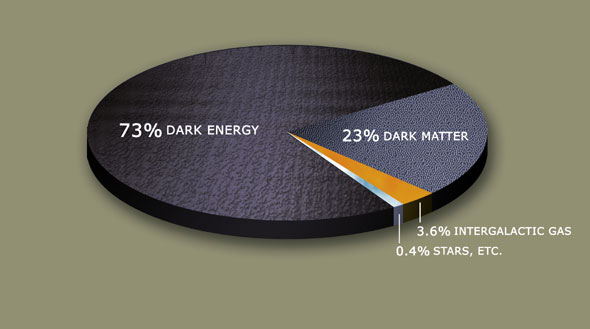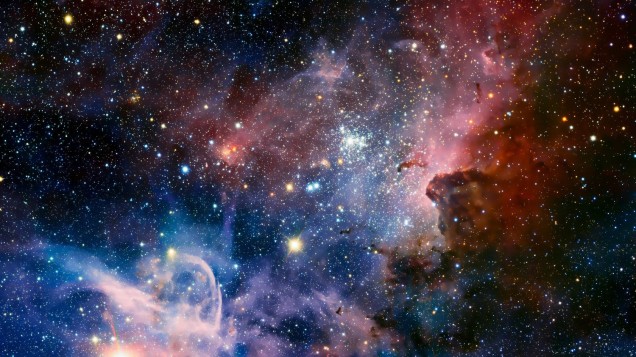Protons, electrons, and neutrons bundled together in an atom are the particles what make most of the visible universe, including the earth, the sun and the distant stars of the galaxies. When we look up the sky, we may don that this stunning enormity mostly consists of the aforesaid particles right? Antagonistically one of the most fundamental discoveries in the 20th century was just opposite and stated that these universally accepted particles constitute less than 5% of the Universe. Yes 5%, so what about the rest 95% then? The rest of the universe is believed to be made up of an enigmatic unnoticeable material known as the dark matter along with a repelling gravitational force known as dark energy.

What is Dark Matter is a fascinating question that gives goosebumps even to some of the finest minds in the field of astrophysics and cosmology. Dark Matter does not interact with baryonic matters and is invisible to light and other forms of electromagnetic radiation, making it impossible to detect even with the most enhanced and sophisticated instruments. So, if we cannot see it and cannot detect it, how can we be so sure of its existence? The answer lies in the gravitational effects these dark matters have on the center of the galaxies as well as the galaxy clusters.
Standard physics states that stars on the edges of a spinning galaxy should move with a slower acceleration compare to the stars orbiting near the boundary conditions of the galactic center, where the galaxy’s visible matters are intensely concentrated. But when theoretical observations were made, it was perceived that the speed of the stars were almost same throughout the stretchable distance of the galactic disc. These observations proved the theoretical conventions that an invisible force is somehow inoculating an invisible gravitational force on the stars orbiting around the edges of a spinning galaxy thus making them accelerate much faster.
There is numerous postulate made on the dark matter and yet a few of them can explain that what it might be? One of the most fundamentally accepted postulate is that Dark matters consists of exotic particles which don’t interact with the photons and electrons but somehow exerts a gravitational pull. Other hypothesis stresses on the modified theory of gravity, which states the existence of manifold forms of gravity, and the far-reaching gravity governing galaxies which are quite different from the gravity to which we are familiar.

The discovery of dark matter was a complete shock to the scientists. Previously they anticipated that the attractive forces of gravity will slow down the expansion of the universe w.r.t time. But little to their expectations, the simulation results send a shock of paranoia among the scientific society, when the results showed that the expansion is actually increasing instead of slowing down. It was almost as throwing a ball up the air hoping it to fall down, but only to see it going up and up.
Physicists now believe that the expansion of the universe is due to the repulsive force engendered by the quantum fluctuations in the halo spaces of the galaxies. To be added, the force gets stronger as the universe expands and thus known as the dark force energy. Unlike dark matter, there is no conceivable explanation for dark energy and is thought to be the fifth fundamental force called quintessence, which fills the universe like a fluid.
Dark energy is steady with the cosmological constant, a mathematical perpetual used by Albert Einstein in his equation of general theory of relativity to fit it in the impression of a stagnant universe. According to the theory, he suggested that this ‘constant’ is a reclusive force which thwarts the gravity thus preventing the galaxies from disintegrating within itself.
Now that we have discovered the universe is expanding with a dark energy in the form of a cosmological constant, we can define the true image of the stretchable space-time into vast cosmos. But even with all this explanation still, leaves the best minds wondering that why and how this strange force arrived in the first place.
Theory or hypothesis?
LikeLike
There is certainly a mountain of observational data to support the existence of dark matter. But there are some merging galaxy cluster systems where the dark matter model can’t seem to explain the anomalies.Where does dark matter come from? That’s a problem, too. Nobody is sure how or where it formed. It had to be in the universe from the beginning, but how did it form? No one is quite sure…yet.
There have been some detections of something, but physicists are still analyzing just what happened. It’s difficult to do this work since the particles, by definition, do not interact with light which is the primary way that we make measurements in physics.Scientists also look for dark matter annihilation in nearby galaxies. Some theories of dark matter claim that WIMPs are self annihilating particles, meaning that when they encounter other dark matter particles they convert their entire masses into pure energy, specifically gamma rays.
So, to answer your question whether it is a hypothesis or theory, the best answer is that there appears to be something, call it dark matter or whatever, that is lurking out in there that we have yet to measure. The alternative is that something is seriously wrong with our theory of gravity. That, while possible, would itself have a difficult time explaining all of the phenomenon that we see in galaxy interactions. Only time will tell.
LikeLike
Grammar!
LikeLike